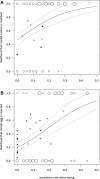Reed warbler hosts fine-tune their defenses to track three decades of cuckoo decline
- PMID: 24299407
- PMCID: PMC4209118
- DOI: 10.1111/evo.12213
Reed warbler hosts fine-tune their defenses to track three decades of cuckoo decline
Abstract
Interactions between avian hosts and brood parasites can provide a model for how animals adapt to a changing world. Reed warbler (Acrocephalus scirpaceus) hosts employ costly defenses to combat parasitism by common cuckoos (Cuculus canorus). During the past three decades cuckoos have declined markedly across England, reducing parasitism at our study site (Wicken Fen) from 24% of reed warbler nests in 1985 to 1% in 2012. Here we show with experiments that host mobbing and egg rejection defenses have tracked this decline in local parasitism risk: the proportion of reed warbler pairs mobbing adult cuckoos (assessed by responses to cuckoo mounts and models) has declined from 90% to 38%, and the proportion rejecting nonmimetic cuckoo eggs (assessed by responses to model eggs) has declined from 61% to 11%. This is despite no change in response to other nest enemies or mimetic model eggs. Individual variation in both defenses is predicted by parasitism risk during the host's egg-laying period. Furthermore, the response of our study population to temporal variation in parasitism risk can also explain spatial variation in egg rejection behavior in other populations across Europe. We suggest that spatial and temporal variation in parasitism risk has led to the evolution of plasticity in reed warbler defenses.
Keywords: Brood parasitism; coevolution; environmental change; phenotypic plasticity.
© 2013 The Authors. Evolution published by Wiley Periodicals, Inc. on behalf of The Society for the Study of Evolution.
Figures




Similar articles
-
Beyond genes-for-behaviour: The potential for genomics to resolve long-standing questions in avian brood parasitism.Ecol Evol. 2024 Nov 17;14(11):e70335. doi: 10.1002/ece3.70335. eCollection 2024 Nov. Ecol Evol. 2024. PMID: 39575141 Free PMC article. Review.
-
Common cuckoos (Cuculus canorus) affect the bacterial diversity of the eggshells of their great reed warbler (Acrocephalus arundinaceus) hosts.PLoS One. 2018 Jan 19;13(1):e0191364. doi: 10.1371/journal.pone.0191364. eCollection 2018. PLoS One. 2018. PMID: 29351548 Free PMC article.
-
Continuous variation rather than specialization in the egg phenotypes of cuckoos (Cuculus canorus) parasitizing two sympatric reed warbler species.PLoS One. 2014 Sep 2;9(9):e106650. doi: 10.1371/journal.pone.0106650. eCollection 2014. PLoS One. 2014. PMID: 25180796 Free PMC article.
-
Defensive adaptations to cuckoo parasitism in the black-browed reed warbler (Acrocephalus bistrigiceps): recognition and mechanism.Anim Cogn. 2022 Oct;25(5):1299-1306. doi: 10.1007/s10071-022-01613-9. Epub 2022 Mar 23. Anim Cogn. 2022. PMID: 35320446
-
A review of the cues used for rejecting foreign eggs from the nest by the Eurasian blackbird (Turdus merula).Ecol Evol. 2022 May 6;12(5):e8886. doi: 10.1002/ece3.8886. eCollection 2022 May. Ecol Evol. 2022. PMID: 35571754 Free PMC article. Review.
Cited by
-
Female Cuckoo Calls Deceive Their Hosts by Evoking Nest-Leaving Behavior: Variation under Different Levels of Parasitism.Animals (Basel). 2022 Aug 5;12(15):1990. doi: 10.3390/ani12151990. Animals (Basel). 2022. PMID: 35953979 Free PMC article.
-
The sight of an adult brood parasite near the nest is an insufficient cue for a honeyguide host to reject foreign eggs.Ibis (Lond 1859). 2015 Jul;157(3):626-630. doi: 10.1111/ibi.12254. Epub 2015 Apr 11. Ibis (Lond 1859). 2015. PMID: 26300559 Free PMC article.
-
Beyond genes-for-behaviour: The potential for genomics to resolve long-standing questions in avian brood parasitism.Ecol Evol. 2024 Nov 17;14(11):e70335. doi: 10.1002/ece3.70335. eCollection 2024 Nov. Ecol Evol. 2024. PMID: 39575141 Free PMC article. Review.
-
A generalist brood parasite modifies use of a host in response to reproductive success.Proc Biol Sci. 2015 Sep 7;282(1814):20151615. doi: 10.1098/rspb.2015.1615. Proc Biol Sci. 2015. PMID: 26336180 Free PMC article.
-
Host personality and seasonal parasitism risk do not account for egg rejection behavior in the azure-winged magpie.Int J Parasitol Parasites Wildl. 2025 Mar 19;26:101056. doi: 10.1016/j.ijppaw.2025.101056. eCollection 2025 Apr. Int J Parasitol Parasites Wildl. 2025. PMID: 40212605 Free PMC article.
References
-
- Agrawal AA. Phenotypic plasticity in the interactions and evolution of species. Science. 2001;294:321–326. - PubMed
-
- Avilés JM, Stokke BG, Moksnes A, Røskaft E, Asmul M. Møller AP. Rapid increase in cuckoo egg matching in a recently parasitized reed warbler population. J. Evol. Biol. 2006;19:1901–1910. - PubMed
-
- Briskie JV, Sealy SG. Hobson KA. Behavioral defenses against avian brood parasitism in sympatric and allopatric host populations. Evolution. 1992;46:334–340. - PubMed
-
- Brooke MdeL. Davies NB. Egg mimicry by cuckoos Cuculus canorus in relation to discrimination by hosts. Nature. 1988;335:630–632.
-
- Brooke MdeL, Davies NB. Noble DG. Rapid decline of host defences in response to reduced cuckoo parasitism: behavioural flexibility of reed warblers in a changing world. Proc. R. Soc. Lond. B. 1998;265:1277–1282.
Publication types
MeSH terms
LinkOut - more resources
Full Text Sources
Other Literature Sources
Miscellaneous
